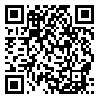Volume 6, Issue 1 (Autumn 2020)
Health in Emergencies and Disasters Quarterly 2020, 6(1): 57-62 |
Back to browse issues page
Download citation:
BibTeX | RIS | EndNote | Medlars | ProCite | Reference Manager | RefWorks
Send citation to:



BibTeX | RIS | EndNote | Medlars | ProCite | Reference Manager | RefWorks
Send citation to:
Nekoiemoghadam M, Moradi S M, Khankeh H R, Masoumi G R, Nejati A, Mehrabi Tavana A, et al . Proposed Solutions to Implement the Priorities of the Sendai Framework to Reduce the Risk of Accidents: A Policy Brief. Health in Emergencies and Disasters Quarterly 2020; 6 (1) :57-62
URL: http://hdq.uswr.ac.ir/article-1-271-en.html
URL: http://hdq.uswr.ac.ir/article-1-271-en.html
Mahmood Nekoiemoghadam1 

 , Seyed Mobin Moradi *2
, Seyed Mobin Moradi *2 

 , Hamid Reza Khankeh3
, Hamid Reza Khankeh3 

 , Gholam Reza Masoumi4
, Gholam Reza Masoumi4 
 , Amir Nejati5
, Amir Nejati5 
 , Ali Mehrabi Tavana6
, Ali Mehrabi Tavana6 
 , Mohammad Hossein Yarmohammadian7
, Mohammad Hossein Yarmohammadian7 
 , Ahmad Jonidi Jafari4
, Ahmad Jonidi Jafari4 



 , Seyed Mobin Moradi *2
, Seyed Mobin Moradi *2 

 , Hamid Reza Khankeh3
, Hamid Reza Khankeh3 

 , Gholam Reza Masoumi4
, Gholam Reza Masoumi4 
 , Amir Nejati5
, Amir Nejati5 
 , Ali Mehrabi Tavana6
, Ali Mehrabi Tavana6 
 , Mohammad Hossein Yarmohammadian7
, Mohammad Hossein Yarmohammadian7 
 , Ahmad Jonidi Jafari4
, Ahmad Jonidi Jafari4 

1- Health in Disaster and Emergencies Research Center, Institute for Futures Studies in Health, Kerman University of Medical Sciences, Kerman, Iran.
2- Health in Disaster and Emergencies Research Center, Institute for Futures Studies in Health, Kerman University of Medical Sciences, Kerman, Iran. ,mobin_moradi@yahoo.com
3- Health in Emergency and Disaster Research Center, University of Social Welfare and Rehabilitation Sciences, Tehran, Iran.
4- Department of Environmental Health Engineering, School of Health, Iran University of Medical Sciences, Tehran, Iran.
5- Department of Emergency Medicine, Prehospital and Hospital Emergency Research Center, School of Medicine, Tehran University of Medical Sciences, Tehran, Iran.
6- Health Management Research Center, Baqiyatallah University of Medical Sciences, Tehran, Iran.
7- Health Management and Economics Research Center,School of Management and Medical Information Sciences, Isfahan University of Medical Sciences, Isfahan, Iran.
2- Health in Disaster and Emergencies Research Center, Institute for Futures Studies in Health, Kerman University of Medical Sciences, Kerman, Iran. ,
3- Health in Emergency and Disaster Research Center, University of Social Welfare and Rehabilitation Sciences, Tehran, Iran.
4- Department of Environmental Health Engineering, School of Health, Iran University of Medical Sciences, Tehran, Iran.
5- Department of Emergency Medicine, Prehospital and Hospital Emergency Research Center, School of Medicine, Tehran University of Medical Sciences, Tehran, Iran.
6- Health Management Research Center, Baqiyatallah University of Medical Sciences, Tehran, Iran.
7- Health Management and Economics Research Center,School of Management and Medical Information Sciences, Isfahan University of Medical Sciences, Isfahan, Iran.
Abstract: (4611 Views)
Accidents and disasters impose enormous costs on governments and nations each year, as well as causing great suffering to people affected by various disasters around the world. Today, accidents and disasters account for a large portion of government resources and programs. Iran is no exception to this rule. It is one of the ten most populated countries globally and the fourth most troubled country in Asia in terms of natural disasters. Therefore, understanding the risks as a basis for future planning is vital. Reducing disaster risk as a global priority requires the collective efforts of policymakers, managers, professionals, and all stakeholders in this field. The Sendai Framework is the most critical UN disaster risk reduction strategy (2015-2030). Considering the importance of the mentioned cases, a group of experts came together and discussed the solutions for implementing the Sendai Framework in Iran using the focus group discussion method. Finally, they prepared the present policy brief. One of the most important strategies is to study the history of risk in different parts of the world and Iran and prepare a risk zoning map, form a transnational and national organization. This map should delegate each authority to a particular organization for risk management, emphasize the correct understanding and upgrade the scientific level of people towards risk awareness. It must pay particular attention to create a culture in the field of risk awareness, analyzing stakeholders to attract support, and create a national information network. The map ought to develop a comprehensive risk management program, expanding education at the level of managers and society, creating and upgrading a quick alert system, and comprehensive preparedness plans. Finally, it can be said that the Sendai Framework is one of the most important documents published to plan for disasters. This planning is not just in the response phase but must be applied at all the crisis management cycle levels.
Type of article: brief report |
Subject:
Special
Received: 2019/10/8 | Accepted: 2020/09/14 | Published: 2020/10/1
Received: 2019/10/8 | Accepted: 2020/09/14 | Published: 2020/10/1
Send email to the article author
| Rights and permissions | |
 |
This work is licensed under a Creative Commons Attribution-NonCommercial 4.0 International License. |





